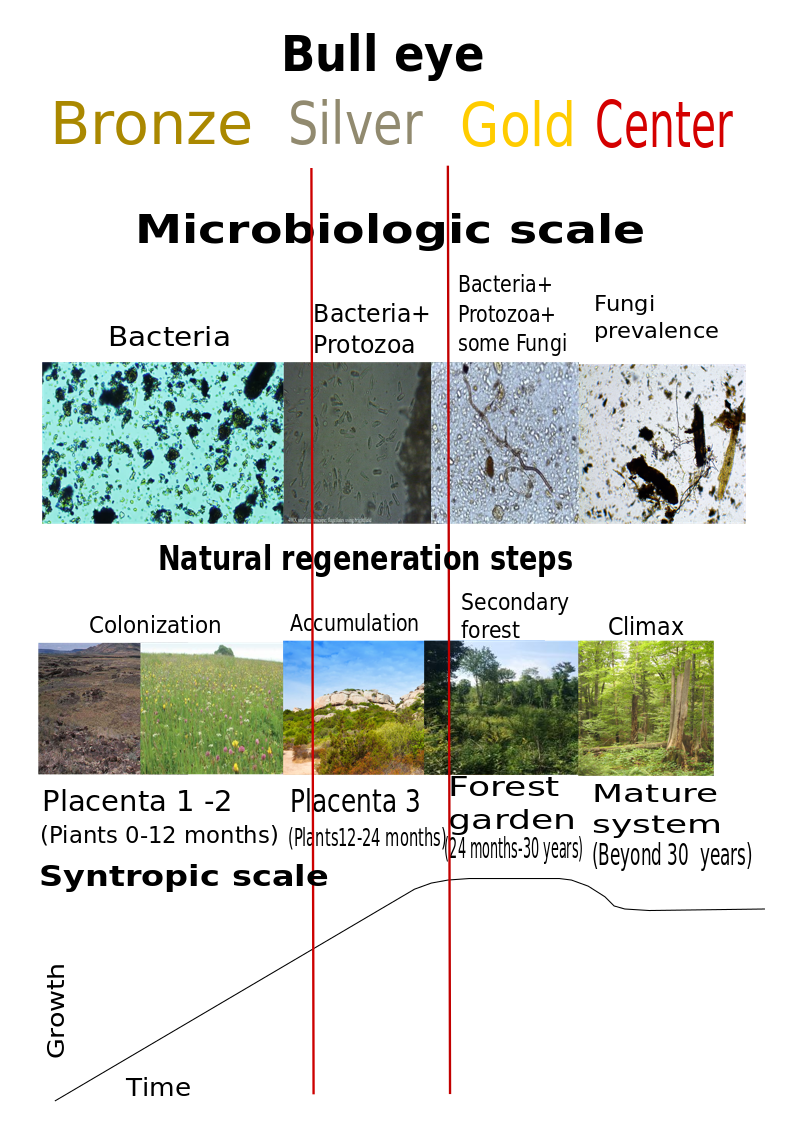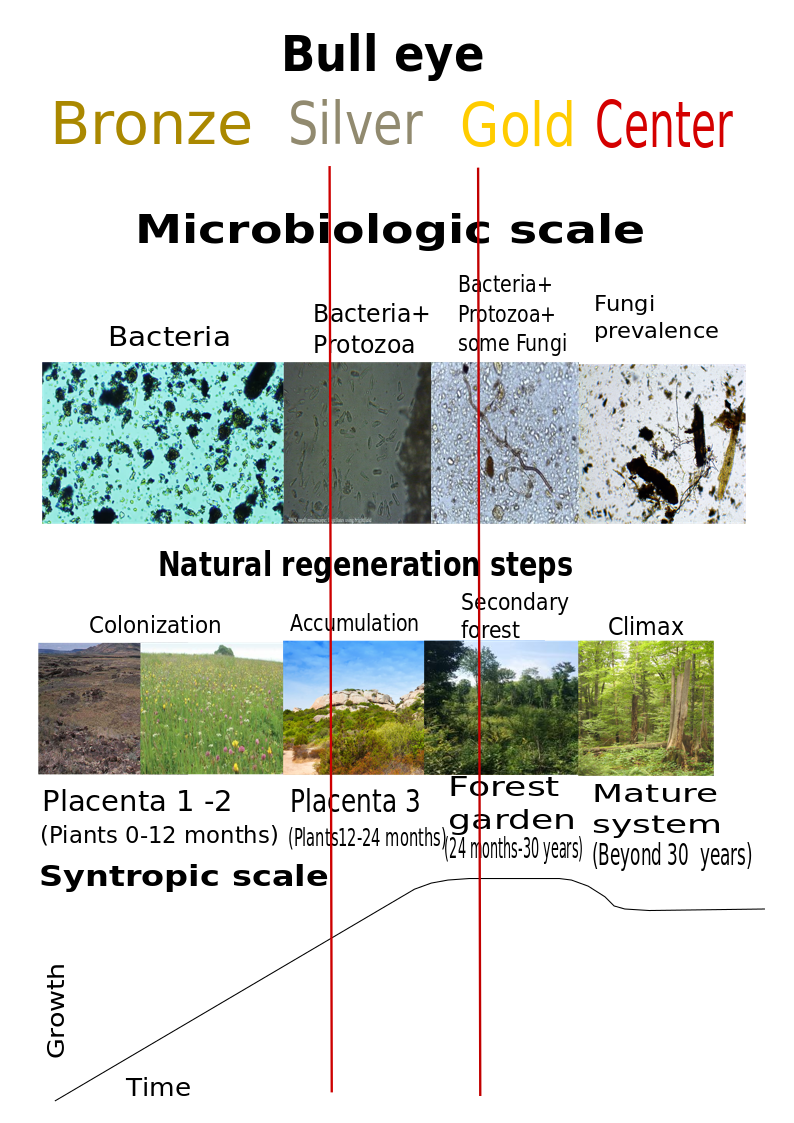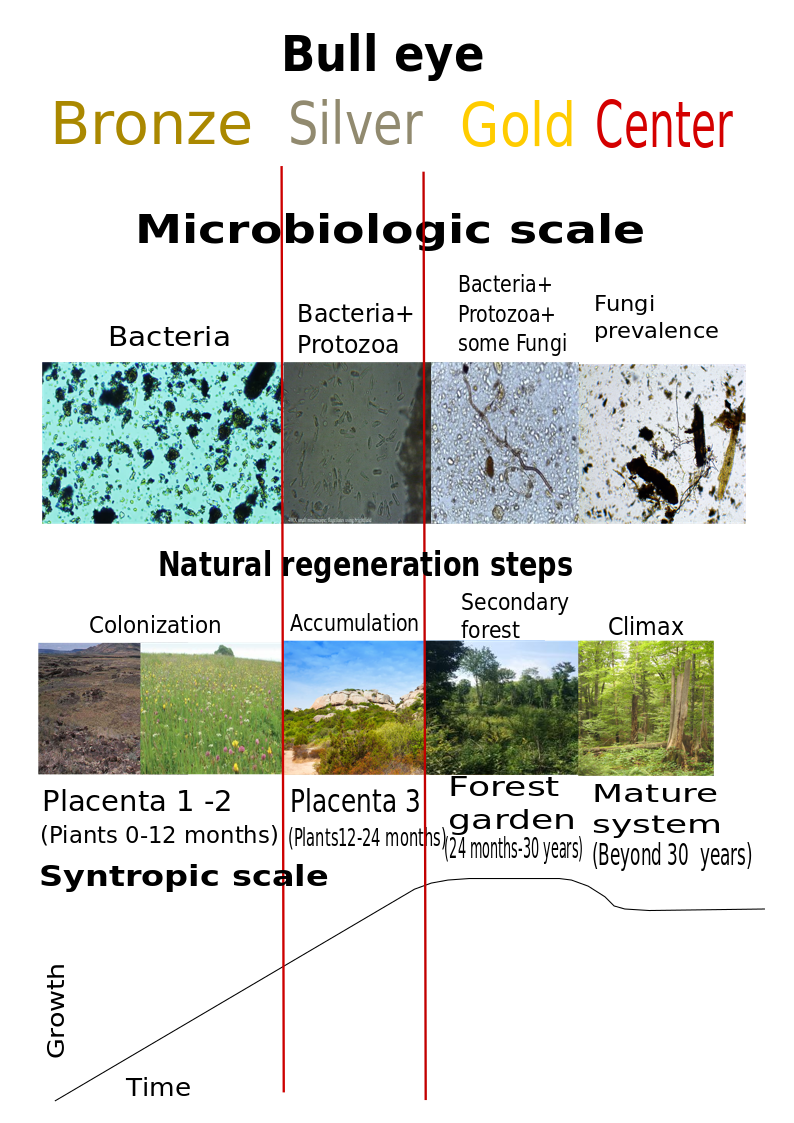
Permaculture design for Stephan Schrotter at Cairo Montenotte, Italy – Part 2
Client Analysis
Context



The context is where the design is happening and in what condition it is before we start designing.
The state of the art is the chart below that compares the observation done through the bull eye and the microbiological tests of the soil, than related to the natural regeneration stages and the syntropic scale.
The chart must be read in vertical to understand the conditions of the land and horizontal to understand the growth and what it changes with the timeline.
The red vertical lines indicate the actual conditions of the land.
The syntropic scale represents the actions that need to be taken in order to improve the land.
After the reading the bull eye system and the microbiological tests the situation is as follows:
State of the art for Field n.1


The actual situation of field n.1 is for the majority accumulation stage and a small part forest garden stage.
This means that it is at a stage of regeneration where it needs to accumulate organic matter, humus, microorganisms etc. It is possible to sow and plant placenta 1-2-3 with some fruits trees.
Because I suggest to proceed in this area with a syntropic permaculture system it will be possible to plant fruit trees, woodland trees (for mulching through chipping) with lower layers of plants that last 12-36 months plus aromatic, strawberries and small fruits (Berries). This stage is also based on a fast growing stage, so all those young plants together will push a fast growing rate where the plants protect each other. We will protect the plants and we will help the land to accumulate more through the use of compost tea.
Once the system reaches the climax stage (at approx 30 years circa) he will bring it back to secondary forest stage via pruning and cutting the existing plants or leave it to grow and harvest available produce.
We clearly understand from the chart of the growth in time that the period of greatest production will be at secondary forest stage where the light arrives to illuminate the forest floor and it will support all the understorey plants.
We will call those understorey layers “Stratification at 7 layers”.
Field n.2


The actual situation of field n.2 is very similar to field n.1. The majority is accumulation stage and for one third forest garden stage where there is more forest garden stage than field n.1 for the amount of fungi in the soil.
This means that it is at a stage of regeneration where it needs to accumulate organic matter, humus, microorganisms etc. It is possible to sow and plant placenta 1-2-3 with fruits trees. I suggest to plant fruit trees such as hazelnut and walnuts with a mix of honeybees. At this stage it is also classed as a fast growing stage, so all those young plants together will push a fast growing rate where the plants protect each other. We will protect the plants and we will help the land to accumulate more through the use of compost tea.
Field n.3


The actual situation of field n.3 is accumulation stage. Because there is a lack of humus and fungi.
This means that it is at a stage of regeneration where it needs to accumulate organic matter, humus, microorganisms etc. It is possible to sow and planting area 1-2-3 with some bushes. In this field I suggest to aromatic plants in order to prepare the soil to accommodate fruit trees later and to help insects and honey bees. It will be possible to keep bees to produce honey. This stage is also a fast growing stage, so all those young plants together will push a fast growing rate where the plants protect each other. We will protect the plants and we will help the land to accumulate more through the use of compost tea.
Field n.4


The actual situation of field n.4 is for the majority accumulation stage and a small part forest garden stage. It is very similar to field n.1
This means that it is at a stage of regeneration where it needs to accumulate organic matter, humus,microorganisms etc. It is possible to sow and plant this area with fruits trees. Because I suggest to proceed in this area with a syntropic permaculture system it will be possible to plant fruit trees, woodland trees (for mulching through chipping) with lower layers of plants that last 12-36 months, plus aromatic, strawberries and small fruits (Berries). This stage it is also based on a fast growing stage, so all those young plants together will push a fast growing rate where the plants protect each other. We will protect the plants and we will help the land to accumulate more through the use of compost tea.
Functions
This is the stage which focus on the design.
Each design needs an objective, a purpose. Analysing what we have understood from the observation stage we need to determine the functions that this design has to satisfy.
There will be a lot but some of them will be more important than others.
A function is what we want to achieve, our objective, our target.
This design tool of the analysis stage called Functions, Systems, Elements is useful to translate the holistic goal, needs, wants in real productive systems that will satisfy the dreams of the client.
| Functions | Systems | Elements |
| Producing good food | Food forest,syntropic permaculture,vegetable forest,permaculture vineyard. | Plants,vegetable,seeds,mulch,manual and mechanical tools |
| Education | Courses | Room,open space,experimental-educational sites |
| Hospitality | Agriturismo | House,kitchen,rooms to rent,bathroom,swimming pool,childrens playground |
| Land regeneration | Mulching,compost,compost tea increase biodiversity,water management,microbiology.natural succession. | Organic matter,air pump,containers,shoulder sprayer,excavations,seeds,plants etc. |
| Water management | Keyline,swale,roof rain harvesting,water well | Excavation,seeds,survey,water tanks,water pipes. |
| Catastrophe prevention | Keyline,swale systems,plants stratification,nutrients accumulation,soil microbiology,hail protection,dripping irrigation system. | Swale,anti-hails plants,mulching plants,seven plants level,irrigation pipes,microbes inoculation |
| Project protection | Fence,hedges,zone 5 | Close plants,nets,chestnut poles etc. |
Web of connections
The web of connections is useful to visualise the connections between different systems/elements of the project. Systems and elements with more connections will be the most important because they will keep the project together in case of extreme events. So,they will be the first to be implemented also because they will help the other systems (with less connections) to start up fast and without problems.

Scale of connections
This scale is the result of the web of connections.
The first system or element is the one with more connections,the last it is the system or element with less connections.
1) Syntropic permaculture,agriturismo
2) Permaculture vineyard,food forest
3) Swale,mulch,courses
4) Keyline dam,compost
5) Water well
6) Hedges
7) Fence
Permaculture E thics
Evaluation of how the most important systems behave in relation of the three permaculture ethics. The ethics of permaculture are our target to reach the sustainability of the project applied to the three areas of our life:
Environment, social and economic. It will be some lists of systems and elements that respect the ethics. If some systems and elements will repeat in more than one ethic then it will be the confirmation that they will be very important for this project.
Care of the earth: Rebuild the natural capital, soils, forests, clean air and water ,diversity of the species etc.
Swales
Hedges
Microbes
Compost
Syntropic permaculture
Mulch
Zone 5
Permaculture vineyard
Keyline dam
Food forest
Courses
People care: Physical, emotional, spiritual, of your family, community, culture and of all humanity as a whole.
Healthy food (through Syntropic p.c. , food forest,p.c. vineyard)
Zone 5
Courses
Reforestation
Agriturismo
Swales and keyline dam
Fairshare (Economy): Limit the consumption, respect of natural limits and fair cooperation and worldwide pacific co-housing. Creating abundance in a finite ambient.
Healthy food (through Syntropic p.c. , food forest,p.c. vineyard)
No chemical substances
Courses
Reforestation
Impact
Some of our options will have more or less impact on the environment than others.
Let’s see the ecological impacts of the different systems proposed in this design.
Hierarchy of the use of the resources
Resources that increase from a modest use: Syntropic permaculture,zone
5,hedges,healthy food,reforestation,food forest,permaculture vineyard,mulch,
Resources that don’t change with use: Swales,keyline dam,courses,zone 5,house roof water harvesting
Resources that disappear or degrade if not used: Water well,dripping irrigation system.
Resources that will reduce in the long run: Fence












